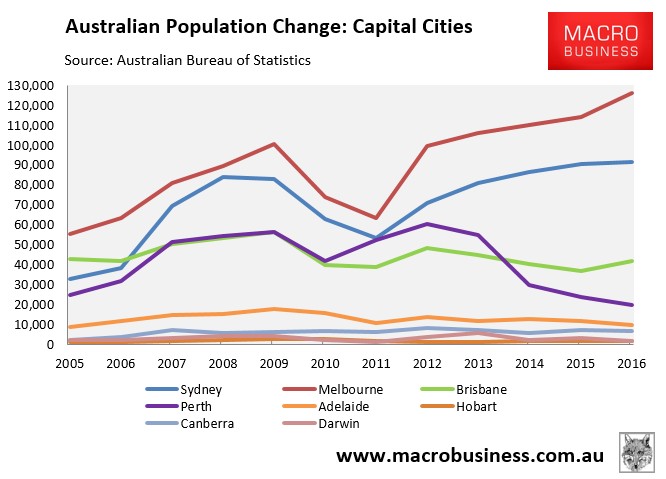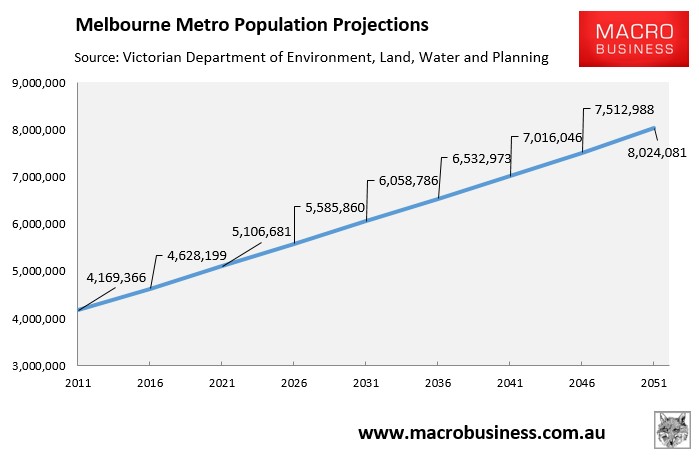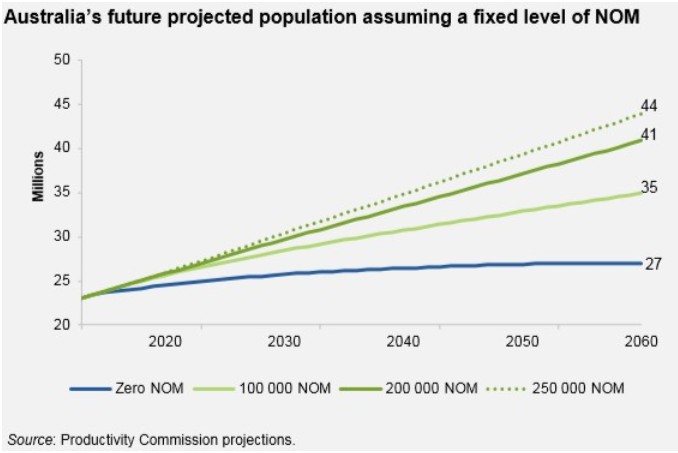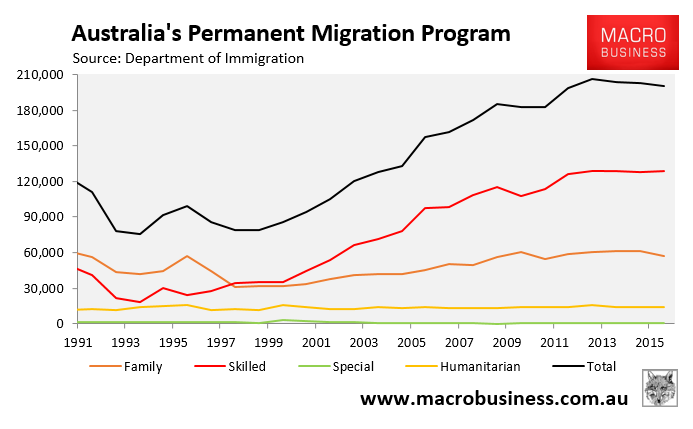With Melbourne’s population surging by an insane 556,000 in the five years to 2016:

And with Melbourne’s population projected to explode by 97,000 people a year to 8 million mid-century:

The Victorian Government has been forced to resort to creative measures to ease congestion, like new sardine configuration trains. From The Age:
Metro’s move to rip out seats from train carriages to accommodate exploding patronage numbers has eased overcrowding on peak services across the network, PTV data reveals.
The seating reconfiguration has increased passenger capacity from 798 to 900, resulting in a dramatic drop in passenger load breaches on the Frankston, Upfield, Sandringham, Werribee and Craigieburn lines…
The removal of train seats comes as Melburnians brace for a shoulder-to-shoulder, Tokyo-style commute on a new fleet of 65 high-capacity trains to be rolled out from mid-2019.
Technical documents show the trains are designed to seat 40 per cent of passengers, but will “enable a future reduction of seating in the range down to 30 per cent of the original gross train capacity”…
Despite Metro’s efforts, some lines on the network are showing signs of overcrowding.
The South Morang line – the route servicing the country’s fastest growing suburb – had a spike in overcrowding this year, jumping from 26 per cent to 33 per cent of passengers crammed inside full trains.
The service is to face high patronage growth, and no peak services will be added, despite an extension of the line to Mernda…
Opposition public transport spokesman David Davis said: “The tearing out of seats to cut train overcrowding is clearly not a long-term solution to the surge in Melbourne’s population and the usage increase and there is no question it smashes passenger comfort.”
Only in Australia would MORE people per carriage equate to LESS overcrowding!
But wait, it’s not just the commuter train network that is being over-run by rampant population growth, but the road system as well. Over the weekend, the person who wrote the transport blueprint for Victoria – Sir Rod Eddington – urged the Andrews Labor government to “get on with” building more roads to tackle the population explosion. From The AFR:
Sir Rod… rejected calls by the Grattan Institute… for a congestion charge saying that “you can’t charge your way out of congestion” because there is no substitute for intelligent growth in road networks…
“It has been some time since we have had a major new road project in Victoria, particularly in Melbourne, and I think its important for the liveability of the city and the state”.
…my own view is the congestion in the road network in Melbourne in particular is a growing problem and it’s not going to be addressed quickly and it’s not going to be addressed through one project.”
According to SBS News, Sir Rod also noted that “governments are also increasingly struggling to find money to build roads themselves and without private sector capital they won’t get done”.
The last point is pertinent. We are often told by population boosters that mass immigration is required to ease the fiscal burden of an ageing population. But this argument never takes into account the huge costs and dis-economies of scale associated with retrofitting our cities to cope with much larger populations (think land buybacks, tunneling, etc).
As noted by Dr Jane O’Sullivan in a submission to the Productivity Commission:
A fiscal burden of more than $100,000 per additional person, or tens of billions of dollars per year, is a huge cost for the government to omit from its balance sheet of costs and benefits of population growth. The cost single-handedly accounts for all increase in government debt since the escalation of population growth from 2004. The Grattan Institute reported “unprecedented infrastructure spending by states and territories is largely responsible for a $106 billion decline in their finances since 2006,” and “after a threefold increase in capital spending over the last 10 years, states are paying 3 per cent more of their revenues in interest and depreciation.”
These figures are based on what has actually been spent. It is evident that expenditure has not been enough, with congestion mounting in transport systems, hospitals, schools, prisons, housing and community facilities.
That’s right, our governments have massively increased expenditure and taken on more debt, but have still failed dismally to keep up with rampant immigration-fueled population growth.
The end result is sardine packed trains, more time stuck in traffic, less affordable (and smaller) homes, schools and hospitals bursting at the seams, as well as increasingly costly infrastructure ‘solutions’. This must be what “prosperity” and “cultural enrichment” looks like to the ‘open borders’ loons on the left.
Of course, anyone with half a brain knows what is driving Melbourne’s falling livability: the federal government’s mass immigration program.
According to the Productivity Commission’s recent Migrant Intake into Australia report, Australia’s population is projected to grow to around 41 million mid-century under current mass immigration settings. This is roughly 14 million more people than would arrive into Australia under zero net overseas migration:

Clearly, the best way to avert Melbourne’s looming infrastructure disaster, as well as maintain decent living standards, is for the the State Government to demand that the federal government slash Australia’s mass immigration program:

Sadly, the Turnbull Government in May announced it would maintain Australia’s permanent migrant intake at a record 205,000 people a year in 2017-18 without a whiff of opposition from Labor or the fake Greens.
Hence, Melbourne’s living standards are destined to be crush-loaded like sardines for the foreseeable future.
And for what?

